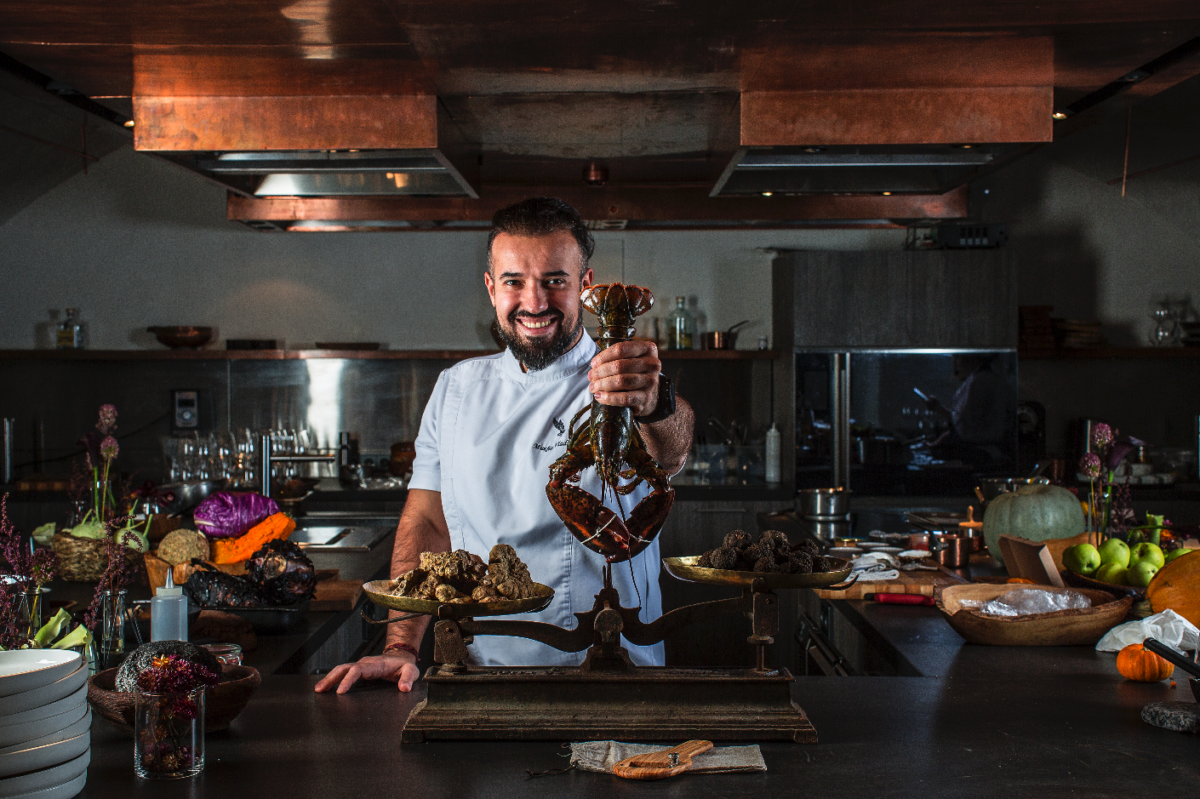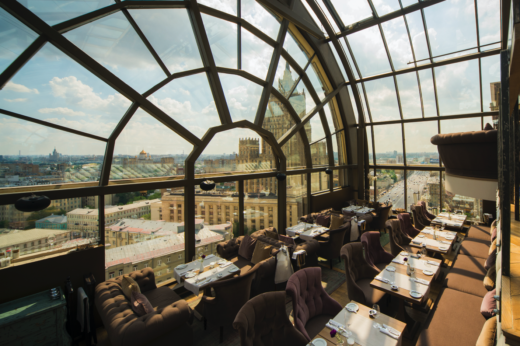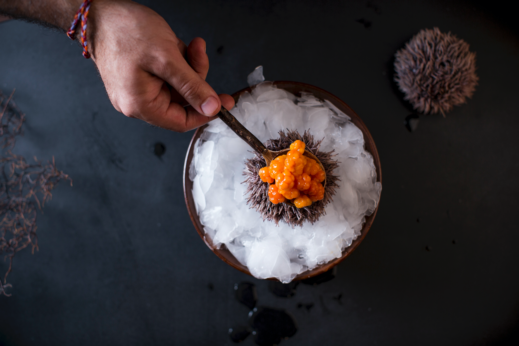Moose Milk Ice Cream and Wood-Fired Cabbage and Caviar Dreams
One chef’s quest to create the new Russian cuisine.
Moose Milk Ice Cream and Wood-Fired Cabbage and Caviar Dreams
One chef’s quest to create the new Russian cuisine.

Vladimir Mukhin was featured in the Netflix documentary Chef’s Table and has attracted the attention of food lovers around the world.Courtesy of White Rabbit
In just two decades, Russian cuisine has gone from drab post-Soviet leftovers (think mayonnaise and salted fish) to a world-class tradition that’s beginning to turn heads. One of the most energetic figures behind this New Russian cuisine is chef Vladimir Mukhin. His restaurant, White Rabbit, located at the top of a 16-story skyscraper in Moscow, is on the “World’s 50 Best Restaurants” list. Taking pre-revolutionary recipes as his inspiration, he set out to, in his own words, “show the world that Russian food exists.” Think moose milk ice cream, cabbage baked in a wood-fired oven with champagne-caviar sauce, and ravioli with Kamchatka crab.

Of course, having a special relationship with food means having a special relationship with farmers. When the farmer who grows Mukhin’s cabbages called, crying and saying that the harvest had frozen, Mukhin came up with a new way to cook the cabbage. Meanwhile, the farm where he gets his moose meat and milk is starting to expand. Mukhin’s appetite for high-quality and exotic products (he now has more than 20 restaurants in the White Rabbit family) is creating demand for farmers all over Russia. Today, New Russian cuisine goes hand in hand with the farm-to-table movement.
If you think of Russian food at all, chances are, you think of beet soup, salted fish, caviar and salads smothered in mayonnaise. But you won’t find those in Mukhin’s kitchen. “People consider me to be a fighter against mayonnaise,” he says with a healthy dose of pride. He is tucked into one of the tables on the lower level of White Rabbit restaurant, overlooking the evening Moscow skyline. Mayonnaise, which Mukhin abhors, is one of the enduring symbols of Soviet food. The calorie-rich spread was mass-produced by order of the Soviet government and used wherever possible, at home and in the ubiquitous stolovoya (cafeteria). Mayonnaise glued together pickled herring and beetroot salad, spoonfuls of mayonnaise were ladled into borscht instead of sour cream, and whitefish was baked with mayonnaise and onions. And mayonnaise is just one such example; Soviet food was standardized and mass-produced to feed the working masses, and high cuisine was disdained as bourgeois.
But Russian cuisine wasn’t always fatty and homogenous. Before the Russian Revolution of 1917, the country was known for sturgeon, mead, wood-fired vegetable pies and cheeses. Today, that history is coming back. White Rabbit currently ranks 15th on the “World’s 50 Best Restaurants” list. It was featured in the Netflix documentary Chef’s Table and has attracted the attention of food connoisseurs from around the world. On the menu is everything from Kamchatka crab (which greets you in a waterfall tank at the entrance to the restaurant) to fried radish with sour cream and pike caviar to wild boar cutlets with lobster sauce.

Mukhin says that the tourists who came to his restaurant when he first started out were usually just looking for a place to eat after visiting Red Square or some other nearby attraction. Now, more people tell him that they come specifically to eat at his restaurant with the goal of trying Russian food. As he travels Russia and the world in search of new recipes and inspirations, he says his task is to “show people that Russian food exists.”
Mukhin’s success isn’t just changing the face of Russian restaurants and the reputation of Russian cuisine globally; his appetite for high-quality products is influencing farming as well. Russia had collective farms during the Soviet period, but demand from restaurants like White Rabbit is helping to create a market for a new generation of farmers and a model of food production where chefs and farmers share an intimate connection.
“Today, a chef isn’t just someone who cooks,” says Mukhin. “It’s someone who grows products for himself and coordinates with farmers.” Dissatisfied with the tomatoes available on the market, the chef has spent almost two years working with a farmer on the Volga River to develop better tomatoes for his restaurant. He has also partnered with a moose farm, which inspired him to recreate an old recipe that calls for moose lips and serve salted caramel moose milk ice cream. The farm is starting to expand and release young moose calves back into the wild.
Just as important to Mukhin is where his vegetables come from. One of the more pleasant surprises on his menu is a wedge of cabbage, baked in a wood-fired oven and drizzled with a champagne-caviar sauce (black caviar, salmon caviar and pike caviar). The velvety softness and sweetness of the cabbage are puzzling at first yet utterly delicious. Turns out, when farmer Svetlana Ivanova called in tears to tell Mukhin that her entire crop of cabbages had frozen, he told her to bring them to the restaurant anyway. He had an idea: The parts of the cabbage that had frozen would be sweeter when baked. It turned out to be a wild success. “For me, cabbage is the Black Square of 2018,” he says. Black Square is a futurist painting by Russian artist Kazimir Malevich. Mukhin believes that food can — and should — be art, and he believes that vegetables are the future of the art that is food.
In the end, Mukhin is not unlike mayonnaise himself. “I’m like glue,” he says, “like a wallpaper glue that sticks talented people together.” His young team is the most important part of his restaurant. “I live for their sake,” he tells me, adding that the next generation of Russian chefs will be even stronger than this one.
Follow us
This work is licensed under a Creative Commons Attribution-NoDerivatives 4.0 International License.
Want to republish a Modern Farmer story?
We are happy for Modern Farmer stories to be shared, and encourage you to republish our articles for your audience. When doing so, we ask that you follow these guidelines:
Please credit us and our writers
For the author byline, please use “Author Name, Modern Farmer.” At the top of our stories, if on the web, please include this text and link: “This story was originally published by Modern Farmer.”
Please make sure to include a link back to either our home page or the article URL.
At the bottom of the story, please include the following text:
“Modern Farmer is a nonprofit initiative dedicated to raising awareness and catalyzing action at the intersection of food, agriculture, and society. Read more at <link>Modern Farmer</link>.”
Use our widget
We’d like to be able to track our stories, so we ask that if you republish our content, you do so using our widget (located on the left hand side of the article). The HTML code has a built-in tracker that tells us the data and domain where the story was published, as well as view counts.
Check the image requirements
It’s your responsibility to confirm you're licensed to republish images in our articles. Some images, such as those from commercial providers, don't allow their images to be republished without permission or payment. Copyright terms are generally listed in the image caption and attribution. You are welcome to omit our images or substitute with your own. Charts and interactive graphics follow the same rules.
Don’t change too much. Or, ask us first.
Articles must be republished in their entirety. It’s okay to change references to time (“today” to “yesterday”) or location (“Iowa City, IA” to “here”). But please keep everything else the same.
If you feel strongly that a more material edit needs to be made, get in touch with us at [email protected]. We’re happy to discuss it with the original author, but we must have prior approval for changes before publication.
Special cases
Extracts. You may run the first few lines or paragraphs of the article and then say: “Read the full article at Modern Farmer” with a link back to the original article.
Quotes. You may quote authors provided you include a link back to the article URL.
Translations. These require writer approval. To inquire about translation of a Modern Farmer article, contact us at [email protected]
Signed consent / copyright release forms. These are not required, provided you are following these guidelines.
Print. Articles can be republished in print under these same rules, with the exception that you do not need to include the links.
Tag us
When sharing the story on social media, please tag us using the following: - Twitter (@ModFarm) - Facebook (@ModernFarmerMedia) - Instagram (@modfarm)
Use our content respectfully
Modern Farmer is a nonprofit and as such we share our content for free and in good faith in order to reach new audiences. Respectfully,
No selling ads against our stories. It’s okay to put our stories on pages with ads.
Don’t republish our material wholesale, or automatically; you need to select stories to be republished individually.
You have no rights to sell, license, syndicate, or otherwise represent yourself as the authorized owner of our material to any third parties. This means that you cannot actively publish or submit our work for syndication to third party platforms or apps like Apple News or Google News. We understand that publishers cannot fully control when certain third parties automatically summarize or crawl content from publishers’ own sites.
Keep in touch
We want to hear from you if you love Modern Farmer content, have a collaboration idea, or anything else to share. As a nonprofit outlet, we work in service of our community and are always open to comments, feedback, and ideas. Contact us at [email protected].by Stephan Sveshnikov, Modern Farmer
April 1, 2019
Modern Farmer Weekly
Solutions Hub
Innovations, ideas and inspiration. Actionable solutions for a resilient food system.
ExploreExplore other topics
Share With Us
We want to hear from Modern Farmer readers who have thoughtful commentary, actionable solutions, or helpful ideas to share.
SubmitNecessary cookies are absolutely essential for the website to function properly. This category only includes cookies that ensures basic functionalities and security features of the website. These cookies do not store any personal information.
Any cookies that may not be particularly necessary for the website to function and are used specifically to collect user personal data via analytics, ads, other embedded contents are termed as non-necessary cookies.
Splendid. Smells of butterscotch and Christmas pudding. Tastes of toffee honey caramel and syrup. Quiet a lot to chew on. The nectar lingers pleasantly so. For those who prefer peaty whiskies I wouldn’t it. But for those who have a sweet tooth as I certainly do it’s glorious. An exceptional whisky. Contender as well as a great alternative to Bourbon.
Cows and goats are already extremely used abhorrently for their milk, please do not glorify the use of moose for their milk now, too. Or their lips…? What kind of recipe calls for moose lips except that of a psychopath? Let’s get back to modern farming here, modern/new doesn’t mean making something like this mainstream.